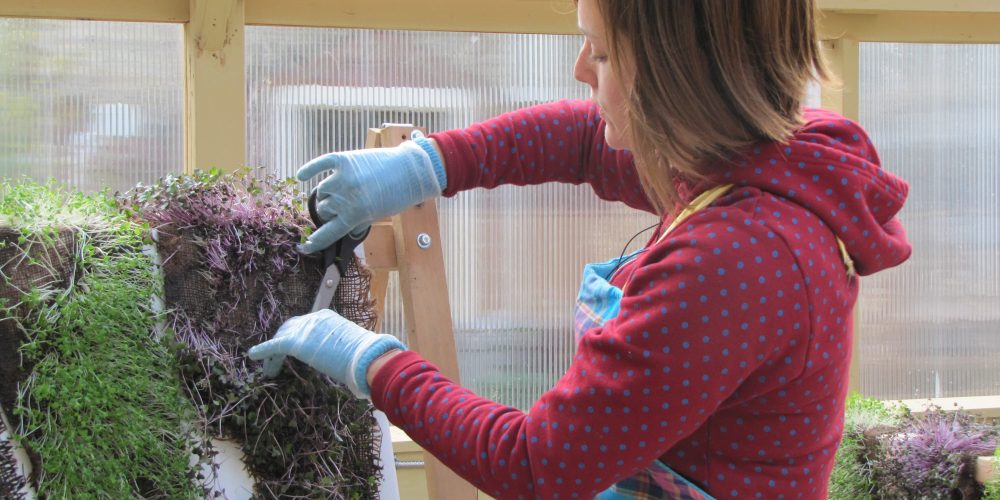What do small-scale farmers and market gardeners do in the winter? This is a perennial question for growers in temperate climates where the growing season for sustainable, local agriculture is traditionally just half of the year.
What do small-scale farmers and market gardeners do in the winter? This is a perennial question for growers in temperate climates where the growing season for sustainable, local agriculture is traditionally just half of the year.
Is wintertime for holiday or time for work? There varying opinions out there.
Elliot Coleman, who literally wrote the book on modern Western organic growing, was an innovator of working through the winter, as evidenced by the titles of his books, “The Four Season Harvest,” and “The Winter Harvest.” He even says, “I believe that energy-efficient, commercial, four-season harvesting can be a reality all across the country. In fact, I even talk about revising the standard farm year, selling vegetables from September to May, and taking my vacation in the summer.”
And they have done this at his Four Season Farm in Harborside, Maine. Coleman’s pride are his unheated “high tunnels,” which are long walk-in tunnels, covered in plastic sheeting that can add months to either end of the growing season. He believes the key is to balance “the technology of climate modification with the biology of the vegetable world” by using primarily passive protection over carefully selected crop varieties that are especially hardy in cooler temperatures, such as lettuces, chard, spinach, or kale. High tunnels can also function as a handy tool for storing vegetables in winter months.
Storing vegetables are another way to extend the season for small growers, especially since they can provide customers with a welcome change from the fresh greens that high tunnels or heated greenhouses supply. Farmers must carefully select seed varieties of beets, cabbages, carrots and others that are suited best for storing, rather than summer eating. However, this also requires the allocation of field space to these vegetables, which can be difficult for those practicing sub-acre market gardening. Storage vegetables are generally land-intensive and low-value, which can prevent farmers from growing more lucrative crops that grow fast and are harvested and sold quickly. So in the absence of having large quantities of storage vegetables to sell over the winter months, what else keeps the market gardener busy while the snow is flying?
Theresa Schumilas, a farmer at the Garden Party CSA in Ontario’s Waterloo Region, wrote an illuminating blog post for the Waterloo Region Food System Roundtable about a produce farmer’s winter life, which can essentially be summarized as, “not lounging on the beach.”
Schumilas does a lot of planning throughout the winter – reflecting on the season’s work, considering what worked well and what didn’t, and ordering seeds accordingly. These are vital tasks in a market gardener’s winter that lay the ground work for a successful season to come. Crop planning involves laying out in meticulous detail what will be planted where and when, as well as creating a document that will constantly be referred to for key information such as planting dates, plant spacing, and projected harvest dates. Planning for the season ahead also entails taking the time to care for and service any farm equipment and machinery, another big part of Schumilas’ winter work. Of course, even amongst all this planning, it’s hard to ask a grower not to grow – even if it is just for a few months!
Jeff Frank and Kristen Illick are the farmers of Liberty Gardens in Coopersburg, Pennsylvania. They grow herbs, vegetables, fruit and flowers through the summer, but in winter it is the microgreens that keeps them going – both keeping them busy and supporting them financially. In an article by the Penn State Extension, he is quoted:
“Growing winter greens gets me out and around in the winter, keeping me recharged. It is very pleasant to be inside the greenhouse with green plants on a dreary winter day.”
Microgreens are just-sprouted baby vegetables that contain highly concentrated nutrients and have been growing in popularity over the last few years. Commonly grown varieties include broccoli, radish, peas, mustards, and sunflower. Chefs use them to garnish a special meal, or to add a punch of flavour to salads or sandwiches. Frank and Illick grow them in heated greenhouses, taking advantage of the sunlight, but keeping the plants protected from the cold.
On the other hand, farmers undeniably earn a chance to relax too. In contrast to Eliot Coleman, Jean-Martin Fortier, another big name in market gardening and a disciple of Coleman’s, prefers to set aside winters for travel, rest, writing and teaching. He has the somewhat unique opportunity to keep busy by leading a number of educational activities and taking part in speaking engagements through the cold months – playing an important role in the advancement of small-scale market gardening practices.
Similarly, Eli Tracy, of Ohio’s Hartsburg Farms, aspires to mimic the writer and farmer Wendell Berry who works long, sweaty hours through the summer, then hibernates inside and writes through the winter. There’s a romantic air to that lifestyle, though it may require some other source of income and careful financial planning. Small-scale agriculture is not known for being highly profitable, though Fortier does maintain in his practical book, The Market Gardener, that it is possible to earn enough through the warmer growing season to go somewhere sunny during the winter.
So, if you thought that small-scale growers have a hard time keeping busy through the winter, think again! Whether it is spent catching up on learning, reading, and writing, spent immersed in planning for the season ahead, or spent growing in a greenhouse, how a farmer spends their winter is as varied as the farmers themselves.
The Working Centre is a local non-profit organization that works to support community-building and good work in Kitchener-Waterloo. With 500 volunteers helping out in 30 different projects, The Working Centre community demonstrates practical action through community service. The urban agriculture projects include Grow Greenhouse and The Hacienda Market Garden (We are always on the look-out for volunteers to work during summer!) Through the winter we offer a Microgreen CSA Share – support us and choose from microgreens, healthy dinners, treats and freshly roasted coffee beans, every week! Visit The Working Centre website to learn more.
References:
Coleman, E. (1995) The New Organic Grower, 2nd ed. White River Junction, Vt: Chelsea Green Publishing Company.
Fortier, J. (2014) The Market Gardener. Gabriola Island, BC: New Society Publishing.
Johnson, M. (2014). Winter on the farm: 5 farmers discuss their plans. Modern Farmer. http://modernfarmer.com/2014/12/winter-farm-5-farmers-discuss-plans/
Penn State Extension. (2013) Growing winter greens. Penn State Extension. http://extension.psu.edu/plants/vegetable-fruit/news/2013/growing-winter-greens
Scumilas, T. (2016) A produce farmer’s winter life. Waterloo Region Food System Roundtable Blog. http://www.wrfoodsystem.ca/blog/2016/01/20/a-produce-farmers-winter-life













